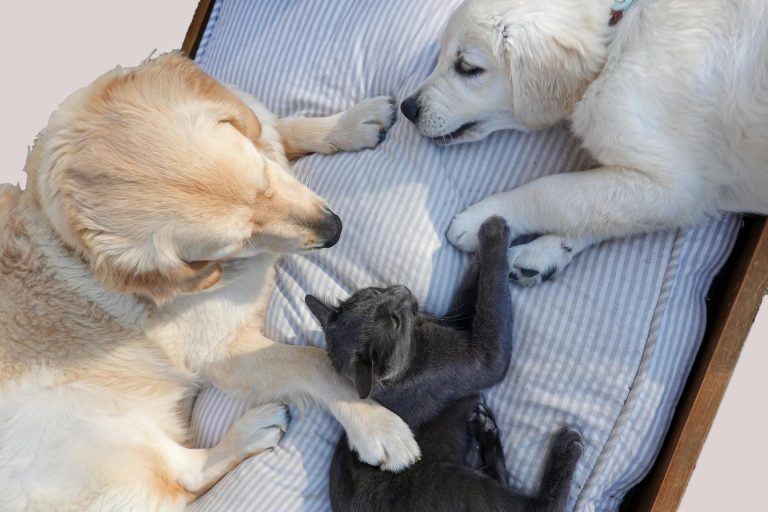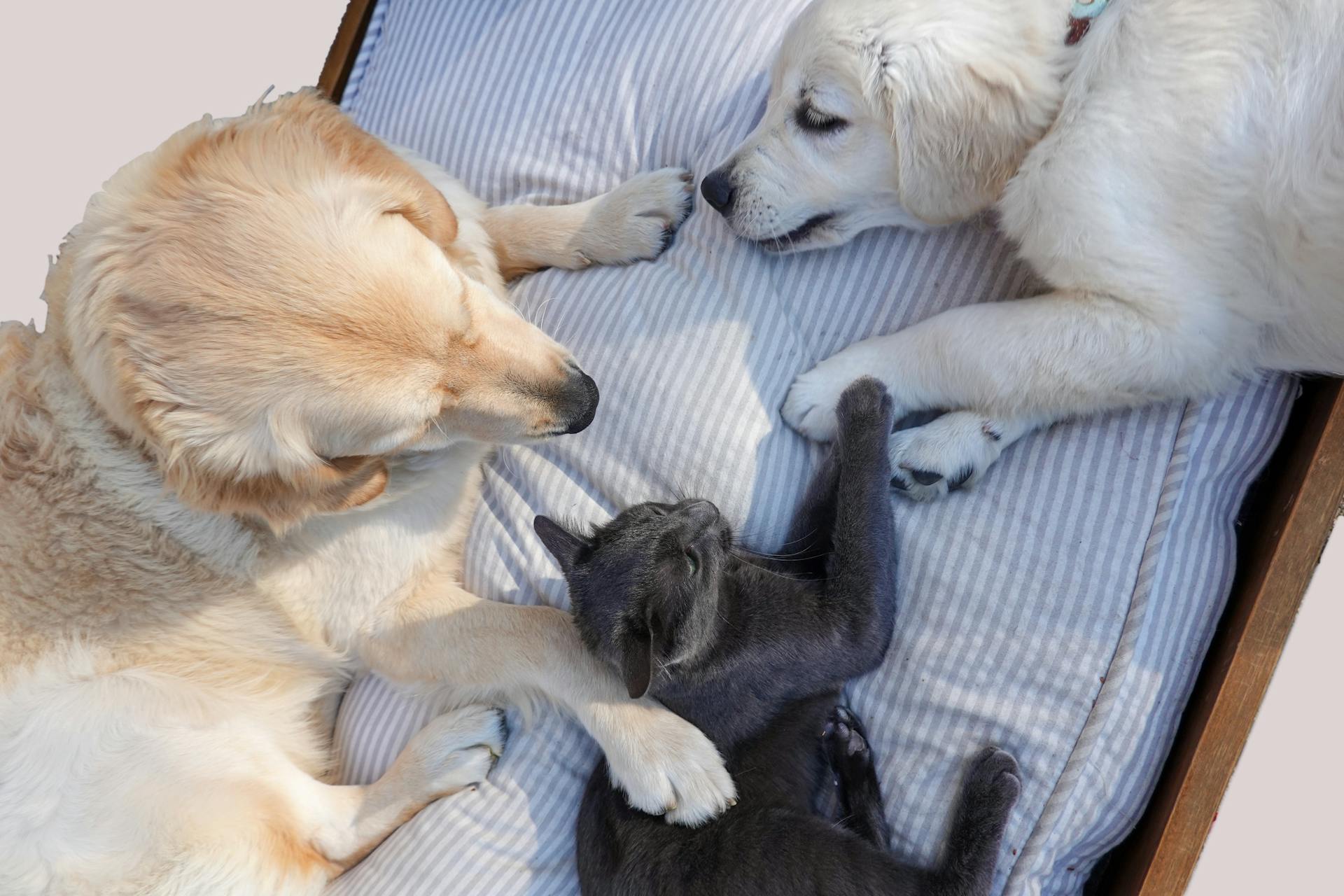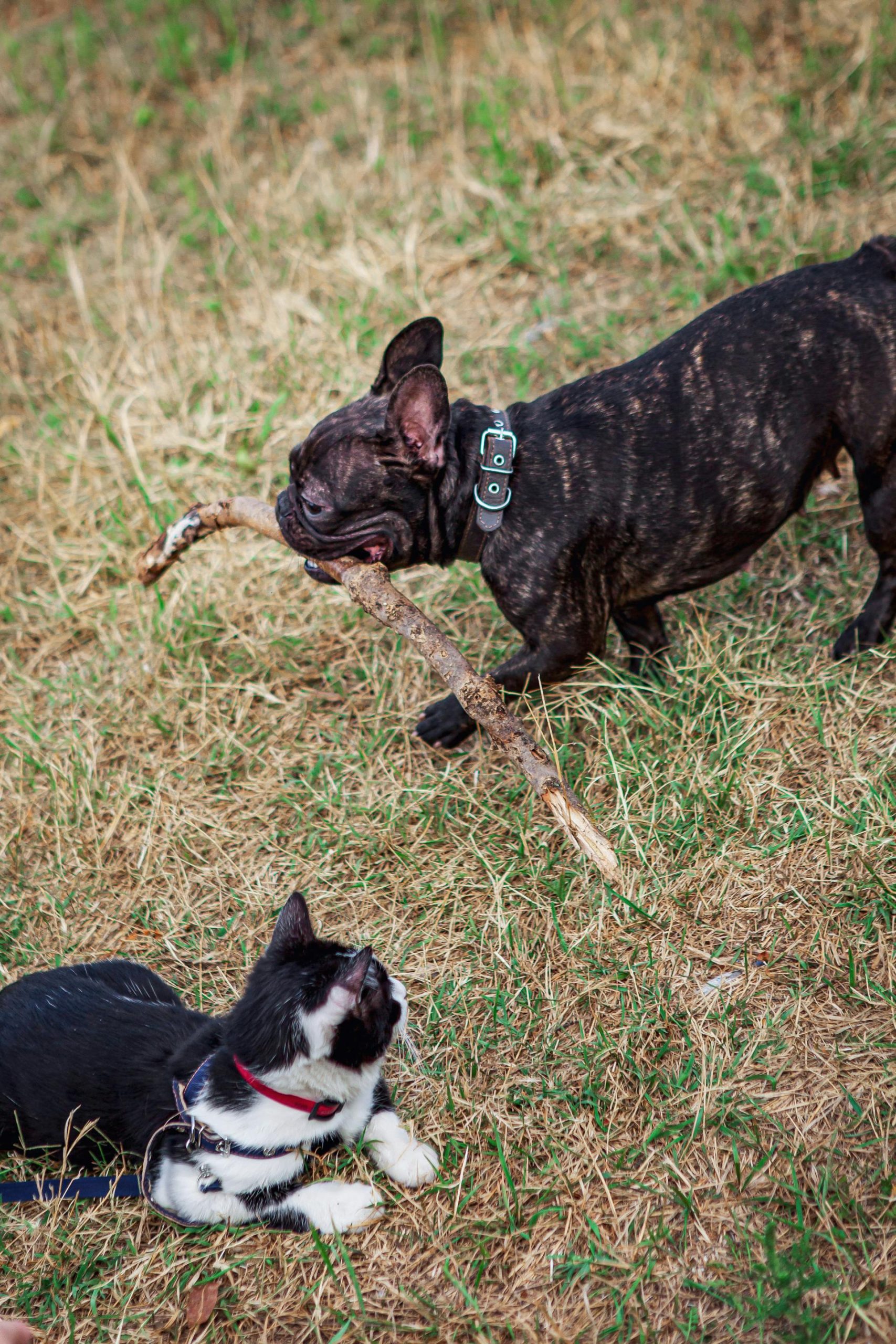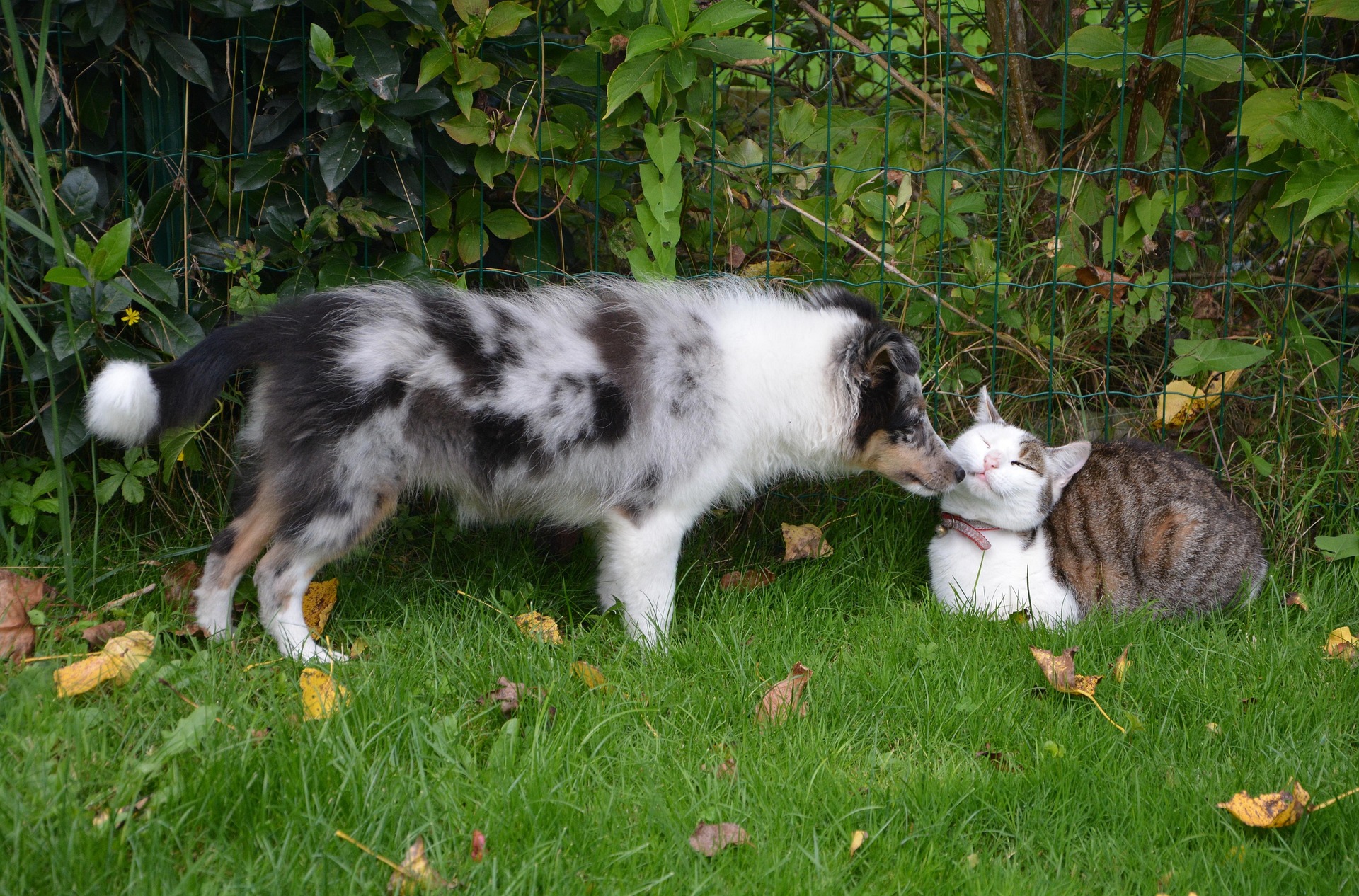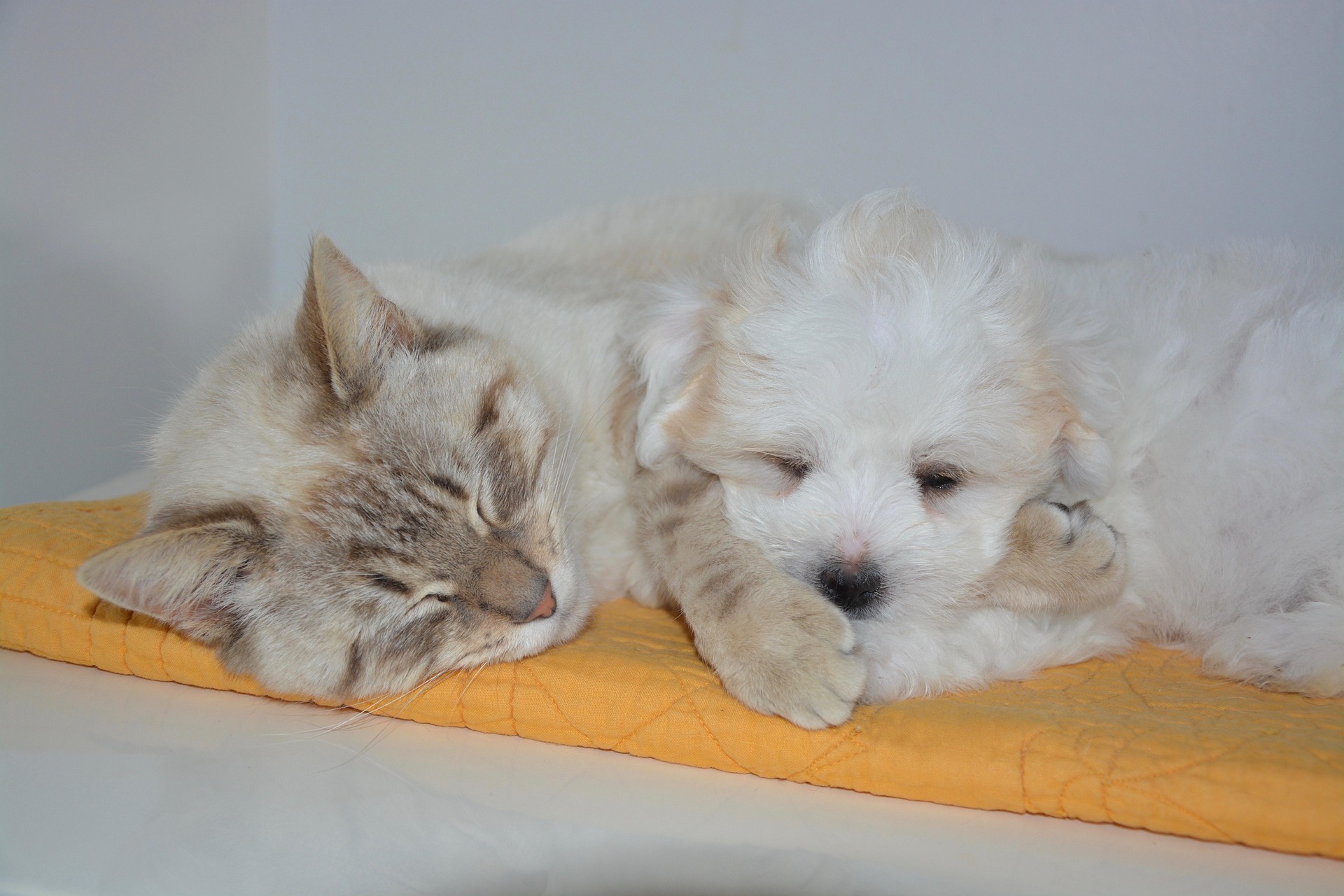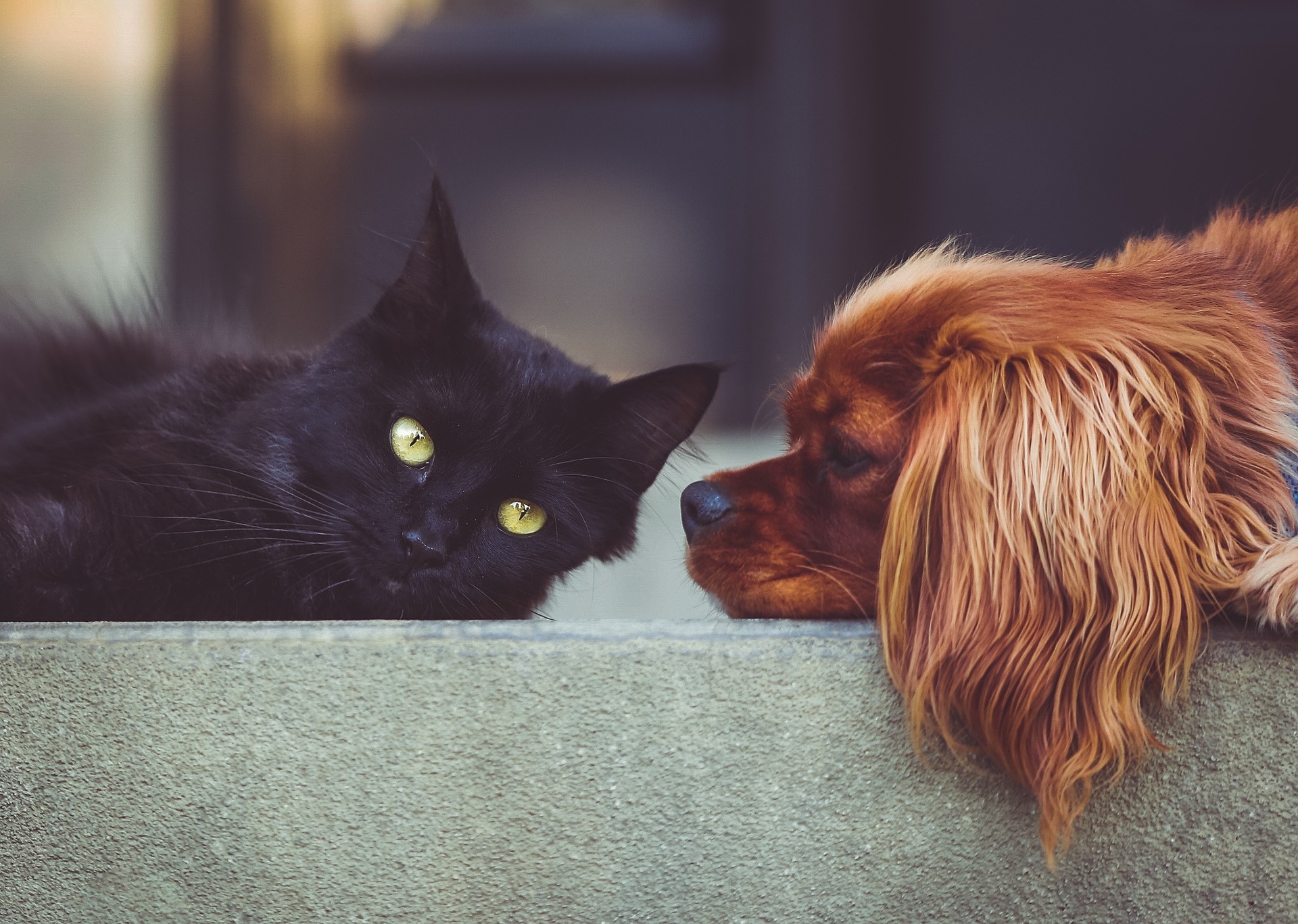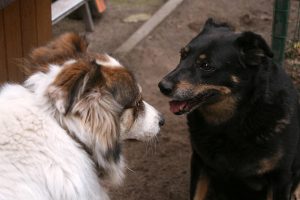You probably have a dog, and now you want to have a cat, but you’re not sure if they will get along well. Or maybe you already have a dog and cat, and you want them to be best friends, but you’re not sure how you can do that.
Don’t worry! We got you covered with these eleven tips that you can use to get a dog and cat to coexist beautifully! You’ll be amazed how they will always have each other’s back after this!
Start with scent swapping before the first meeting
Dogs and cats rely heavily on scent to understand their environment. Before bringing them face to face, exchange their bedding or rub a cloth on one animal and place it near the other’s food bowl. Do this for three to five days.
The cat learns the dog’s scent while eating, which creates a positive association. The dog does the same with the cat’s scent. This preparation reduces the shock of the first encounter. Skip this step and you risk immediate conflict driven by unfamiliar smells.
Keep the first introduction brief and controlled
The first meeting should last no more than five minutes. Put your dog on a leash and keep the cat in a carrier or behind a baby gate. Let them observe each other from a distance of at least six feet.
Watch for calm body language. A relaxed dog will have loose shoulders and a gently wagging tail. A calm cat will have normal-sized pupils and ears facing forward. If either animal shows signs of stress (lunging, hissing, stiff posture), end the session immediately.
Repeat these short sessions twice daily. Increase the duration by two to three minutes each day only if both animals remain calm.
Give the cat vertical escape routes
Cats feel safer when they can climb above ground level. Install cat shelves, provide tall cat trees, or clear space on top of bookshelves. Place these in every room where the dog has access.
A 2015 study published in the Journal of Feline Medicine and Surgery found that cats in multi-pet households showed 67% less stress-related behavior when they had access to elevated perches. The height allows cats to observe dogs without feeling threatened.
Position at least one elevated spot near the cat’s food and water. This lets the cat eat without worry that the dog will approach.
Feed them in separate locations
Dogs often eat faster than cats and may try to steal cat food. Cat food contains higher protein and fat levels that can upset a dog’s stomach. Feed your pets in different rooms with closed doors between them.
If separate rooms are not possible, feed the cat on an elevated surface the dog cannot reach. A counter or high table works. Feed the dog in a crate or behind a baby gate.
Set consistent meal times rather than free-feeding. This prevents food guarding behavior and reduces competition.
Teach your dog the “leave it” command
This command tells your dog to ignore the cat. Start training with treats before introducing the cat. Hold a treat in your closed fist. When your dog stops trying to get it and looks away, say “leave it” and give a different treat from your other hand.
Practice this fifty times over several days. Then try it with the cat present but at a distance. When your dog looks at the cat, say “leave it.” If the dog turns attention back to you, reward immediately with a high-value treat like chicken or cheese.
Repeat this during every interaction until your dog consistently ignores the cat on command. This typically takes two to four weeks of daily practice.
Create separate safe spaces for each pet
Your cat needs a room where the dog cannot enter. Set up a bedroom or bathroom with the cat’s litter box, food, water, and bed. Install a cat door or keep the door cracked just wide enough for the cat to slip through.
Your dog needs a similar space. This could be a crate, a specific room, or a corner with a bed and toys. Both animals should know they can retreat to these areas whenever they feel overwhelmed.
Never force either animal out of their safe space to interact with the other. This breaks trust and increases stress.
Supervise all interactions for the first month
Do not leave your dog and cat alone together until you have seen consistent peaceful behavior for at least thirty days. Even breeds known for being cat-friendly can have prey drive triggered by a running cat.
During supervision, keep your dog leashed for the first two weeks. This gives you immediate control if the dog lunges or chases. Remove the leash only after the dog shows zero interest in pursuing the cat.
If you must leave the house, separate the animals in different rooms. The risk of injury is too high during the adjustment period.
Exercise your dog before cat interactions
A tired dog is a calm dog. Take your dog for a 30-minute walk or play fetch for 20 minutes before any planned time with the cat. Physical exercise reduces excess energy that might otherwise turn into chasing behavior.
Mental stimulation also helps. Give your dog a puzzle toy or practice training commands for 10 to 15 minutes. This focuses the dog’s mind on tasks rather than the cat.
Plan these pre-interaction exercises twice daily during the first month. As the animals become comfortable with each other, you can reduce the frequency.
Reward calm behavior around each other
Catch your pets being good. When your dog lies down quietly while the cat walks by, immediately give the dog a treat. When your cat stays relaxed while the dog moves through the room, offer the cat a treat or play session.
Use high-value rewards like small pieces of cooked chicken, tuna, or commercial training treats. The reward must be special enough to create a strong positive association.
Time the reward within three seconds of the calm behavior. Any longer and the animal will not connect the reward to the action. Repeat this every single time you observe peaceful coexistence during the first six weeks.
Manage the cat’s litter box access
Dogs sometimes eat cat feces, a behavior called coprophagia. This is unpleasant and can spread parasites. Place the litter box in a location the dog cannot reach.
Options include a room with a cat door, behind a baby gate with the bottom raised six inches (cats can slide under, dogs cannot), or inside a cabinet with a cat-sized entry hole.
Clean the litter box twice daily during the adjustment period. Fresh waste attracts dogs more than settled waste. The more often you scoop, the less opportunity the dog has to develop this habit.
Consider the ages and temperaments before adoption
If you are choosing which pet to add to your household, younger animals adapt more easily. A puppy under six months old will often accept a cat as part of the family without issues. A kitten under four months old will grow up seeing the dog as normal.
Adult dogs with high prey drive (terriers, sight hounds, some herding breeds) may never reliably coexist with cats. Ask shelters or breeders about the dog’s history with cats. Many shelters conduct cat tests where they observe the dog’s reaction to a calm cat behind a barrier.
For cats, most will adapt to dogs if given proper time and space. Cats with previous positive exposure to dogs adjust faster. Senior cats over ten years old may find the stress of a new dog too difficult.
Match energy levels when possible. A hyperactive young dog will overwhelm a calm older cat. A playful kitten may frustrate a senior dog who wants to rest.
The timeline for success
Every household is different, but most dogs and cats reach a peaceful coexistence within two to four months. Some pairs become friends within weeks. Others take six months to stop hissing or barking at each other.
Signs of successful integration include relaxed body language when near each other, the cat entering rooms where the dog is resting, the dog ignoring the cat’s movements, and both animals eating or sleeping in the same room without tension.
Do not expect your dog and cat to cuddle or play together. Some do, but many simply tolerate each other’s presence. Tolerance is success. Friendship is a bonus.
If after three months you see no improvement, consult a veterinary behaviorist. These specialists hold advanced degrees in animal behavior and can identify issues you might miss. Some animals have anxiety or past trauma that requires professional intervention.
What to avoid When You Have a Dog and Cat in Your Household
Never punish either animal for hissing, barking, or showing fear. These are communication signals. Punishment teaches animals to suppress warnings, which can lead to sudden attacks without warning signs.
Do not force interactions. Holding a cat while a dog sniffs them creates fear in the cat. Dragging a reluctant dog toward a cat increases stress in the dog. Let both animals approach each other voluntarily.
Avoid yelling or making loud corrections. This adds tension to an already stressful situation. Use calm, quiet commands and separate the animals if needed.
Do not expect instant friendship. Even in ideal conditions, trust takes time to build. Rushing the process causes setbacks.
When coexistence may not work
Some dogs have prey drives too strong to overcome. If your dog has killed small animals in the past, shows intense fixation on the cat despite weeks of training, or has injured the cat, coexistence may not be safe.
Some cats remain terrified despite all efforts. If your cat stops eating, hides constantly for more than two weeks, or shows signs of stress like overgrooming or inappropriate urination, the situation may not be viable.
In these cases, rehoming one animal protects both their welfare. This is not failure. This is responsible pet ownership.

